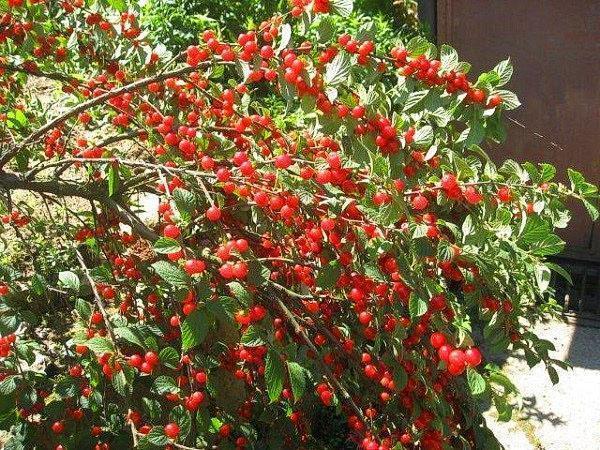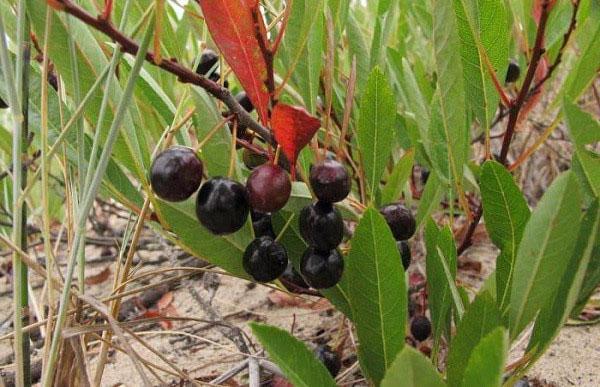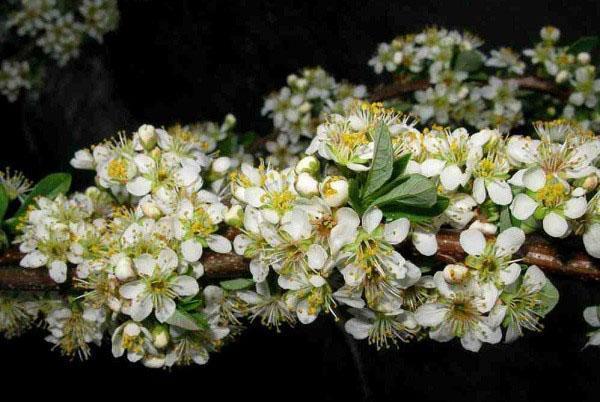Bessey cherry - an ornamental shrub or a delicious berry?
 The Bessey cherry is a subspecies of the low-growing sandy cherry that grows in South and North America. Sand cherries are not suitable for eating because of the unpleasant taste of the berries, which are also very small. At home, it is most often used as feed in a subsidiary farm or as an ornamental shrub in a flower bed. However, thanks to the scientist C.E. Bessie, this variety was improved, and the result was the Bessey cherry, which was named in his honor. The palatability has undergone positive changes, and the variety has become widely known.
The Bessey cherry is a subspecies of the low-growing sandy cherry that grows in South and North America. Sand cherries are not suitable for eating because of the unpleasant taste of the berries, which are also very small. At home, it is most often used as feed in a subsidiary farm or as an ornamental shrub in a flower bed. However, thanks to the scientist C.E. Bessie, this variety was improved, and the result was the Bessey cherry, which was named in his honor. The palatability has undergone positive changes, and the variety has become widely known.
Read also the article: varieties of felt cherries with photos and descriptions!
Cherry Bessey - variety description

Bessey's reputation as an ornamental shrub is well deserved, since during flowering the bush is completely covered with small white flowers with red stamens. Moreover, in the presence of flowers of both sexes - both male and female.
 The leaves of this variety are more like willow leaves than cherry leaves - the leaf shape is elongated, flattened-oval, the green color slightly gives off silver. By the fall, they turn red, which further draws attention to the bush. Besseya belongs to partially self-fertile varieties, however, in order to increase the amount of yield, it still needs additional pollination. It is better if it is a neighbor with a different form.
The leaves of this variety are more like willow leaves than cherry leaves - the leaf shape is elongated, flattened-oval, the green color slightly gives off silver. By the fall, they turn red, which further draws attention to the bush. Besseya belongs to partially self-fertile varieties, however, in order to increase the amount of yield, it still needs additional pollination. It is better if it is a neighbor with a different form.
 The variety itself does not yet have a sufficiently good subspecies, but work in this direction is underway. So, for today it has been possible to bring out an experimental subspecies with darkish and yellow berries and capable of producing up to 10 kg of berries from one bush.
The variety itself does not yet have a sufficiently good subspecies, but work in this direction is underway. So, for today it has been possible to bring out an experimental subspecies with darkish and yellow berries and capable of producing up to 10 kg of berries from one bush.
 Cherry Bessey is quite high-yielding, it begins to bear fruit every year from the second year of life. A decrease in yield occurs after 14 years. The berries can have a slightly round or elongated shape, large (2.5 g), saturated almost dark brown in color. But there are also varieties with yellow or green fruits. The taste lacks the characteristic sourness of cherry, the berry is rather tart-sweet, a bit like bird cherry or mountain ash.
Cherry Bessey is quite high-yielding, it begins to bear fruit every year from the second year of life. A decrease in yield occurs after 14 years. The berries can have a slightly round or elongated shape, large (2.5 g), saturated almost dark brown in color. But there are also varieties with yellow or green fruits. The taste lacks the characteristic sourness of cherry, the berry is rather tart-sweet, a bit like bird cherry or mountain ash.
Bessey's flowering period begins two weeks after the common cherry blossoms (usually the end of May) and lasts 3 weeks.
The cherries are fully ripe by mid-August, but they do not crumble themselves. Left on a branch, under the influence of sunlight, the berries lose their tart aftertaste and wilted. But this is rather an advantage of the variety, because the taste of such cherries only improves.
Planting seedlings
 Planting and caring for Bessey cherries is akin to a simple cherry. The most optimal period for planting seedlings is spring. Saplings, which had a closed root system when sold (in a container), can be planted in early autumn.
Planting and caring for Bessey cherries is akin to a simple cherry. The most optimal period for planting seedlings is spring. Saplings, which had a closed root system when sold (in a container), can be planted in early autumn.
When buying a seedling in late autumn, it is better to dig it in until spring.
It is better to plant cherries in a sunny area with a hill. When planting a garden, a distance of at least 2 meters is left between the seedlings. Although Besseya is not demanding on the soil, it has been noticed that she develops better in sandy soil.On heavy soil, pebble or crushed stone should be used for drainage, and sour soil should be limed with dolomite flour. Sand is added to the clay soil to loosen it.
Fertilizers should be applied to the prepared planting pit:
- superphosphate;
- ash;
- compost.
 In order to avoid decay of the root system from stagnant moisture in the pit, make a mound and put a seedling on it and cover it with soil. Afterwards pour with warm water. Although, of course, it would be better to prepare the planting hole in advance - this way the soil will have enough time to settle.
In order to avoid decay of the root system from stagnant moisture in the pit, make a mound and put a seedling on it and cover it with soil. Afterwards pour with warm water. Although, of course, it would be better to prepare the planting hole in advance - this way the soil will have enough time to settle.
A hybrid of Bessey cherry and plum varieties
 Besseya cherries are good to use as a rootstock for plums. As a result of crossing, a fairly productive variety with a height of about 2 meters is obtained. Fruiting begins in the second year, the yield increases annually. The fruits of the hybrid are similar in taste to a plum, but not as large (up to 25 g).
Besseya cherries are good to use as a rootstock for plums. As a result of crossing, a fairly productive variety with a height of about 2 meters is obtained. Fruiting begins in the second year, the yield increases annually. The fruits of the hybrid are similar in taste to a plum, but not as large (up to 25 g).
When planting hybrid seedlings, the distance should be increased to 2.5-3 meters, while several varieties must be planted simultaneously, since hybrids need pollinators. You can use the Bessey cherry itself for these purposes. A hybrid of cherry and plum is propagated by horizontal layers from the lower branches. If planted through a seed, the seedling will show signs of only one of the varieties used (either cherry or plum).
Breeders are also working to create a hybrid variety with apricot and cherry plum.
Features of caring for Bessey cherries
 Bessey's cherry is unpretentious in care, has increased frost resistance and vitality, is not afraid of drought, and is resistant to diseases.
Bessey's cherry is unpretentious in care, has increased frost resistance and vitality, is not afraid of drought, and is resistant to diseases.
So that the bush is not too thick, in the spring it must be cleared and unnecessary shoots cut out. It is also recommended to cut branches older than 7 years, since with age they almost fall on the ground and give a meager harvest. Do not forget to process the cut site with garden varnish.
Do not despair if the bush dries up badly. In this case, cut off the dead branches on a stump, and soon new shoots will appear from it.
To activate growth, if necessary, the cherries are fertilized nitrogen fertilizersbut healthy bushes won't need it. It is better to use potash for them. Cherries also need complex fertilization by foliar spraying, which is carried out at least three times per season.
A feature of the Bessey variety is the complete absence of root growth inherent in simple cherries, which greatly facilitates caring for it.
If cherry branches fall on the ground under the weight of the harvest, a support must be made around the bush.
For the winter, the branches should be bent and covered. With a large amount of precipitation, the snow around the bush is carefully cleaned, but the branches cannot be completely bare, otherwise they will die.
 Besseya's cherry is propagated by horizontal layers. For this, the lower branches are bent to the ground and fixed for their further rooting. After forming their own root system at the branches, they can be dug up and planted as separate seedlings.
Besseya's cherry is propagated by horizontal layers. For this, the lower branches are bent to the ground and fixed for their further rooting. After forming their own root system at the branches, they can be dug up and planted as separate seedlings.